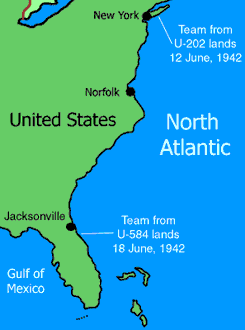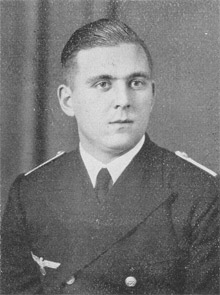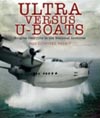Special Operations
German saboteur landings in June 1942
Shortly after he declared war on the United States on Dec 11, 1941 Adolf Hitler wanted to show Americans that they were not safe inside their borders even so far from the battlefields of Europe. He ordered a sabotage operation against targets inside America and Abwehr, the defence intelligence unit, got the job.
This was something the Abwehr people had already done in other countries of Europe and were well suited for. They operated a sabotage school near Brandenburg to train operatives.
The man given the task was the 37-year old Walter Kappe. He knew the United States well, having lived there for 12 years. He was a long-time member of the Nazi party as well (pretty much required for any real career in the intelligence services). The operation was known as Operation Pastorius, named after a German settler in America.
Kappe found 12 men needed for the job through the files of the Ausland Institute. That institute had organized the return of thousands of Germans from America. 4 men dropped from the group right away but the other 8 were split into 2 groups.
The first group was manned by John Dasch, 39 who was to lead the team. His 3 members were Ernest Peter Burger, Heinrich Heinck and Richard Quirin. The 2 last named men were both machinists who had been working for Volkswagen.
The second team was led by Edward Kerling, 32. His 3 men were Hermann Neubauer, Werner Thiel and Herbert Hapt, the youngest man in the 8 man group at 22.
The assembled group of men arrived in the Abwehr school in early April 1942 where they went into training. On May 23 they got their assignments. Dasch and his team were to destroy the hydroelectric plants at Niagara Falls, the Aluminum Company of America factories in Illinois, Tennessee and New York. A cryolite plant in Philadelphia and the locks on the Ohio River between Louisville and Pittsburgh were also to be bombed.
Kerling's team should blow up the Pennsylvania Railroad station in Newark, the famous horseshoe bend section on the railroad near Altoona plus other vital railroad parts. They were also to attack the lock and canal installations at St. Louis and Cincinnati and the water supply system for New York City.
Both teams were to plant bombs in Jewish-owned stores and in locker rooms at major passenger railroad stations to spread fear and panic.
Kerling's team boarded the U-584 (Kptlt. Joachim Deecke) which left its Brest, France base on May 25, 1942 under the command of Kptlt. Joachim Deecke. The destination was a beach near Jacksonville, Florida. Dasch and his team left Brest, France aboard U-202 (Kptlt. Hans-Heinz Lindner) the next day with the destination of south shore of Long Island, near East Hampton.
Both teams were to bury their munitions crates on the beach where they could be obtained later and then head inland and set up false identities. They planned to get together in Cincinnati on July 4.
Each group was supplied with $50,000 to pay for living expenses, travel and the expected bribes. The men themselves were then given $9,000 (5,000 of which was kept by the team leader). This was all real US money and not SS forgeries as in some other cases in the war. Both teams were given a handkerchief that carried the names of contacts and mail drops in America written in invisible ink.
Each team was supplied with 4 waterproof crates, roughly twice as big as a shoe box each. Three of them were filled wit explosives while the fourth contained the fuses, wires and acid.
As planned by Abwehr these were only the first 2 teams of many being sent to America, when fully operational Kappe would join his men and lead their activities.
 Dasch's teams was the first to land in America when U-202, after 15 days at sea, submerged during day and racing on the surface at night, made landfall at 11 PM on June 12. Dasch and his men were dressed as German marines to avoid being shot if caught during landing. Two armed sailors from the boat brought the men to shore in a dinghy.
Dasch's teams was the first to land in America when U-202, after 15 days at sea, submerged during day and racing on the surface at night, made landfall at 11 PM on June 12. Dasch and his men were dressed as German marines to avoid being shot if caught during landing. Two armed sailors from the boat brought the men to shore in a dinghy.
While the group was burying their equipment and uniforms Dasch went over the next small sand dune to scout out the area. Suddenly he noticed a young Coast Guardsman walking directly to their area. To keep the man from seeing the half-buried boxes on the beach Dasch walked towards him and claimed they were stranded sailors. When he refused the offer to rest in the nearest Coast Guard station, only half a mile away, the young Coast Guardsman became suspicious.
Dasch knew their cover was blown and he asked the young man about his family status and then offered him a bribe, then increased the amount after the man had rejected the first offer.
However the young Coast Guardsman did not stay quiet as planned but told his supervisors immediately, turned in the money, and brought some of his mates back to the beach where they spotted the U-202 departing from the beach in the fog. By early morning the Coast Guard had all the boxes dug up from the beach, being in possession of everything the Germans had brought except their clothes and money, and the FBI had been notified.
The FBI imposed a news blackout and launched the largest manhunt in its history, they had nothing to work with though and the team slipped through their nets into New York City.
After buying clothes and splitting into two pairs, Dasch and Burger began to talk about the operation and the situation back in Germany they realized their plans were the same; to betray the operation to the Americans.
The reason for this decision is not quite clear, Dasch probably believed their cover had already been blown by the Coast Guardsman and it would be best to play along to avoid execution. Both men insisted on being anti-Nazis after their capture. Dasch at least could have been telling the truth when he stated that he had planned to scuttle the mission from the very moment he was recruited. Burger probably figured out that once Dasch had voiced his intentions that it would be best for him to play along or to kill Dasch. Burger was not a killer and he agreed to Dasch's plan.
On June 15 Dasch and Burger made up their plans for their surrender. Dasch would go to Washington D.C. and turn himself in while Burger would keep Heinck and Quirin at bay.
One thing that worried Dasch was that while in the Abwehr school Kappe had claimed that the FBI had been penetrated by the Gestapo. He called the FBI in New York City and left a message that he would have information for Hoover in 2 days. He then left for Washington.
That same day the second team, led by Edward Kerling landed uneventfully on Ponte Verda Beach 25 miles south-east of Jacksonville, Florida. They buried their equipment and then boarded their trains, Kerling and Thiel to Cincinnati and Haupt and Neubauer for Chicago.
George Dasch turned himself in after arriving in Washington and, after being sent from office to office, he finally found a man, Agent Ladd, who bought the story, albeit after Dasch had dropped $84,000 on his desk. He was not treated as the hero he probably believed he would be but was put through a 13-hour interrogation and debriefing. He revealed where the other members were staying and they were promptly picked up.
The capture of the second team was a bit more difficult since Dasch only knew that the teams were to meet in Cincinnati on July 4. He did have the handkerchief listing the German contacts in America that he gave to the FBI.
One by one the men were picked up, Hermann Neubauer being the last one from the second team to be arrested.
When all the 7 men had been arrested the FBI officially arrested Dasch. To his disappointment they treated him just a guilty as the others. He wished to be kept in the same quarters as the others so they would not know he turned them in.
Roosevelt ordered that a military tribunal would trial the case, the first time such a tribunal had been set up since the assassination of Abraham Lincoln.
The trial last most of July and the prosecution asked for the death penalty, the standard punishment for espionage during wartime. Due to the co-operation of Dasch and Burger it was difficult to sentence them to death. Burger was give life of hard labour while Dasch was sentenced to 30 years in prison. The other 6 members of the teams were electrocuted at the Distinct Jail in Washington D.C. on 8 August, 1942.
The FBI, fearing more such landings, took appropriate precautions and put out an alert for Walter Kappe and other known men from the Abwehr sabotage school.
Dasch and Burger were deported to Germany in 1948 after almost 6 years in prison. Dasch was vilified in Germany as Burger blamed him for the death of their 6 partners. Dasch published a book in his defence in 1959 and then disappeared from public life.



